RISCO Group PIR 312PR User Manual [en, it, es, fr]

PIR Outdoor Detector Rivelatore da Esterno ad Infrarosso Passivo
Detector de Exterior PIR Détecteur IRP extérieur
Detector Infravermelho Passivo para área Externa
WatchOUT 312PR
Installation Instructions - Relay & BUS Modes
Istruzioni per l’installazione in modalità Relé e BUS Instrucciones de Instalación - Modos Relé y BUS Guide d'installation - Modes Relais et BUS Instruções de Instalação - Modos Relé & BUS
Portuguese Français Español Italiano English

2 |
WatchOUT PIR Installation Manual |

Table of Contents
Relay Mode Installation
Introduction
Mounting
Mounting Considerations Wall Mount Installation Flat Mounting:
45° angle Mounting (Left side mounting) Changing Back Tamper position
Terminal Wiring DIP Switch Settings
Detection Range Adjustment
Walk test
LEDs Display
Relay Mode / Bus Mode Jumper
Optional Swivel Installation (Not Supplied)
Wall Mounting
Swivel Conduit Mounting
(using Conduit Metal Swivel Adaptor - CSMA, Figure 8, Detail A)
Replacing Lenses Technical Specification Ordering Information Accessories Kits
BUS Mode Installation
Introduction
Terminal Wiring
Cover and Back Tamper
Cover Tamper Only
Cover Tamper to Zone Input
DIP Switch Settings
ProSYS Programming
WatchOUT PIR Installation Manual
4
4
4
4
6
6
6
7
7
8
8
9
10
10
10
10
11
12
13
13
13
14
14
14
14
14
14
14
15
3
English
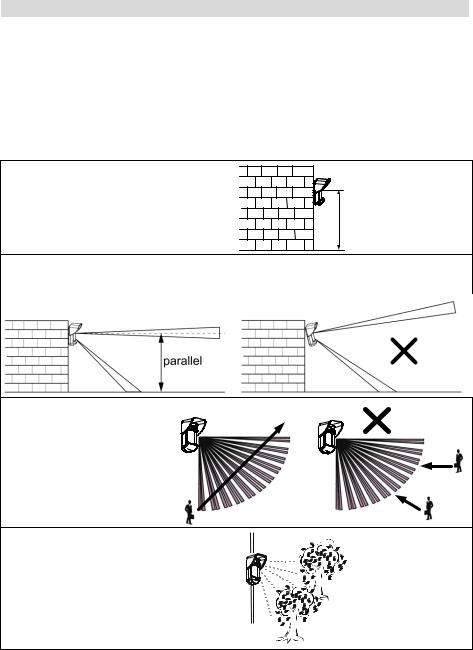
Relay Mode Installation
Introduction
RISCO Group's WatchOUT 312PR, is a unique detector with signal processing based on two Passive Infrared (PIR) channels. The detector has an adjustable detection range. The detector can operate as a regular relay detector connected to any control panel, or as a BUS accessory when connected to RISCO Group's ProSYS control panel via the RS485 BUS, thus having unique remote control and diagnostic capabilities.
The following instructions describe the installation of the WatchOUT in Relay & BUS mode.
Mounting
Mounting Considerations
1. Installation Height: 0.8m - 1.2m |
|
(2'8" – 3'11") |
0.8m -1.2m |
Typical Installation Height: 1m (3'3") |
(2'8" - 3'11") |
2.To ensure maximum operational reliability, install the detector perpendicular to the ground so that the upper detection area is parallel to the ground.
ü
3. For optimum detection, |
ü |
|
|
select a location that is likely |
|
to intercept an intruder |
|
moving across the coverage |
|
pattern. |
|
4. Avoid pointing the detector to moving objects (swaying trees, bushes etc.)
4 |
WatchOUT PIR Installation Manual |
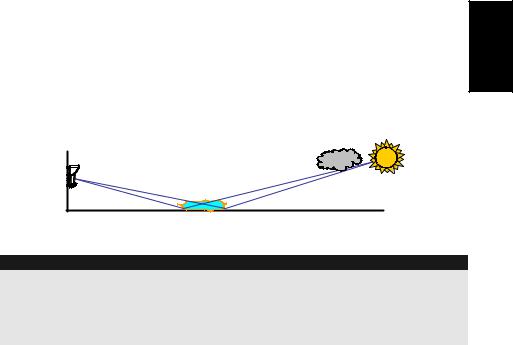
Installing the WatchOUT 312PR in challenging situations
In the following situations, rapid and significant infrared radiation changes can happen in both PIR channels together, resulting in false alarms and therefore care should be taken.
1.Situations in which metal and/or glass objects measuring over 70cm (2‟4”) in height from the ground are in the field of view of the detector (cars, metal gates, shutters, metal walls, windows, etc.)
2.Situations in which a reflective surface on the ground larger than 1m (3‟4”) in diameter may cause reflection into the detector‟s lens. Examples of a reflective surface on the ground are a puddle, wet road or car park, smooth concrete or asphalt surface, swimming pool, etc.
Water Reflection |
English
NOTES:
1.Please note that any outdoor PIR detector will require reduction in range to a shorter distance than the car, metal object or surface reflection (so that these objects won‟t be protected) in order to eliminate false alarms.
2.For full 15m (50’) coverage in the above situations, it is highly recommended to install the
WatchOUT DT, the only outdoor detector with 2 PIR channels and 2 Microwave channels.
3.WatchOUT detectors include high quality Silicon filters on the PIR sensors for blocking out white light interferences. These filters are not intended to block infrared thermal radiation.
WatchOUT PIR Installation Manual |
5 |
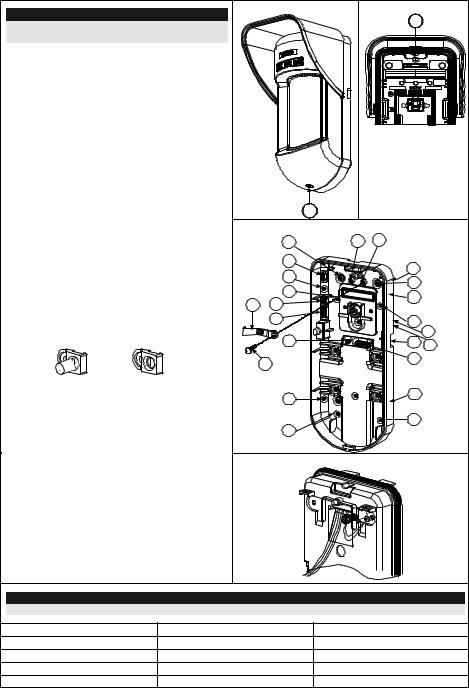
Wall Mount Installation |
|
|
|
|
|
|
|||
Note: |
|
|
Figure 1 |
|
|
Figure 2 |
|
||
|
|
|
|
|
|
I1 |
|
||
The installation knockouts numbering are marked on |
|
|
|
|
|||||
|
|
|
|
|
|||||
the back plate. |
|
|
|
|
|
|
|
||
1. Open WatchOUT front cover (unlock C1, |
|
|
|
|
|
|
|||
|
Figure 1). |
|
|
|
|
|
|
|
|
2. Release internal base (unlock I1, |
|
|
|
|
|
|
|||
|
Figure 2). |
|
|
|
|
|
|
|
|
3. Select mounting installation as follows: |
|
|
|
|
|
|
|||
Flat Mounting: |
|
|
|
|
|
|
|
||
Open knockouts on external base (Figure 3). |
|
|
|
|
|
||||
|
B1 - B4: Wall mounting knockouts |
|
|
|
|
|
|
||
|
T1: Back tamper knockout |
|
|
|
|
|
|
||
|
|
W2 / W3: wires entry knockouts |
|
|
|
|
|
|
|
45° angle Mounting (Left side |
|
|
|
|
|
|
|||
mounting) |
|
|
|
C1 |
|
|
|
||
|
|
|
|
|
|
|
|||
|
a. Open knockouts on external base |
Figure 3 |
|
|
|
|
|||
|
|
|
|
|
|
|
|||
|
(Figure 3). |
|
|
|
T1 |
T6 |
T5 |
|
|
|
|
|
|
|
|
||||
|
L1, L2: Left mounting knockouts |
|
|
T3 |
|
|
|
||
|
|
|
|
|
|
|
|
|
|
|
T3: Left tamper knockout |
|
|
L1 |
|
T4 |
|
||
|
W5 / W6: Wire entry knockouts |
|
|
|
T2 |
|
|||
|
Tamper |
|
|
|
|
||||
|
b. Remove tamper spring |
Lever |
|
B1 |
|
R1 |
|
||
|
B |
W5 |
|
|
|
||||
|
|
|
|
|
|
(not visible) |
|||
|
c. Replace tamper bracket (Item 1) with |
|
|
|
|
||||
|
|
W6 |
|
|
B2 |
(not |
|||
|
|
|
|
|
|
|
visible) |
||
|
supplied flat tamper bracket (Item 2). |
|
|
|
|
||||
|
|
|
|
|
|
W7 |
|||
|
|
|
|
|
|
|
|
|
|
|
|
Item 1 |
Item 2 |
|
|
W3 |
|
W9 W8 |
|
|
|
|
|
|
|
|
|
W2 |
(not |
|
|
|
|
A |
|
|
|
visible) |
|
|
|
|
|
|
|
|
|
|
|
|
d. Insert Tamper lever B onto T5 and T3 |
|
|
L2 |
|
R2 |
|
||
|
and secure screw A (Figure 3) |
|
|
|
(not visible) |
||||
|
|
|
|
|
|||||
4. |
Insert external wires through external base |
|
|
|
B3 |
|
|||
|
W2, W3 (Flat Mounting) or W5, W6 (Left |
|
|
B4 |
|
|
|
||
|
|
|
|
|
|
|
|||
|
side mounting)(Figure 3). |
|
|
|
|
|
|
||
5. |
Secure external base to the wall. |
Figure 4 |
|
|
|
|
|||
6. Insert external wires and tamper wires |
|
|
|
|
|
|
|||
|
through internal base (Figure 4). |
|
|
|
|
|
|
||
7. Secure internal base to external base (lock |
|
|
|
|
|
||||
|
I1, Figure 2). |
|
|
|
|
|
|
|
|
8. Close the front cover (Lock C1, Figure 1) |
|
|
|
|
|
|
|||
|
after wiring and setting DIP switches. |
|
|
|
|
|
|
||
9. Walk test the detector. |
|
|
|
|
|
|
|
||
Note: |
|
|
|
|
|
|
|
|
|
For 45° right side installation use the equivalent units on the external base as follows: |
|
|
|||||||
Knockouts Description |
|
Left |
|
|
|
Right |
|
||
Mounting Knockouts |
|
L1, L2 |
|
|
|
R1, R2 |
|
||
Tamper spring knockouts |
|
T1,T3 |
|
|
|
T2,T4 |
|
||
Tamper screw anchor |
|
T5 |
|
|
|
T6 |
|
||
Wiring Knockouts |
|
W5, W6 |
|
|
|
W7, W8 |
|
||
6 |
|
|
WatchOUT PIR Installation Manual |
|
|
|
|||

Changing Back Tamper position
The back tamper is by default secured on the right side of the internal base (Rear view). If you wish to move it to the left side (rear view), do the following (Figure 5):
1.Remove tamper screw 1 in order to release the tamper from position 7.
2.Ensure tamper spring 2 rests over tamper wire base 4.
3.Ensure plastic tamper bracket 3 rests over both 2 and 4.
4.Secure tamper screw 1 into 3 over position 6.
Figure 5
Left Side
Tamper
6
Right Side
Tamper
3 |
7 |
1

 5 4
5 4
2
Notes:
a.Verify that you hear a "Click" when attaching the tamper spring to the wall.
b.For pole installation, the tamper can be moved to the bottom right-hand side of the internal base.
Terminal Wiring
12VDC
|
+ - YEL GRN ALARM |
TAMPER FREE |
LED |
FREE N.O COM N.C |
|
|
|
||||
|
|
|
ENABL |
||
|
N.C |
N.C |
WatchOut 312PR - PCB |
||
|
|
|
WatchOUT PIR - PCB |
||
+,- |
12 VDC |
|
|
|
|
YELLOW |
N/A (Used only for BUS mode installation) |
|
|
||
GREEN |
N/A (Used only for BUS mode installation) |
|
|
||
ALARM |
N.C relay, 24VDC , 0.1A |
|
|
|
|
TAMPER |
N.C relay, 24VDC , 0.1A |
|
|
|
|
FREE |
A free terminal that can be used to connect wires and EOL resistors |
||||
LED |
Used to remotely control the LEDs when DIP1 is set to ON (used in high security |
||||
ENABLE |
environments). |
|
|
|
|
|
LED Enable: input is +12V OR no terminal connection. |
||||
|
LED Disable: Connect the input to 0V. |
|
|
||
N.O |
Programmable auxiliary relay terminals. This relay is used to activate auxiliary |
||||
COM |
units such as cameras or lighting when an alarm is triggered. |
||||
The operation of the auxiliary relay depends on the settings of DIP switches 4-7. |
|||||
N.C |
|||||
NORMAL |
|
ALARM |
|||
|
|
||||
English
N.O |
COM |
N.C |
N.O |
COM |
N.C |
WatchOUT PIR Installation Manual |
7 |
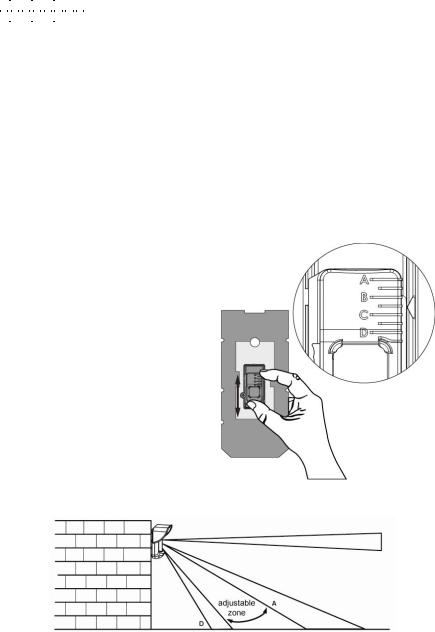
DIP Switch Settings
ON |
|
|
|
|
|
|
|
|
|
|
|
|
|
|
|
|
|
|
|
|
|
|
|
|
|
|
|
|
|
|
|
|
|
|
Factory |
||
|
|
|
|
|
|
|
|
|
|
|
|
|
|
|
|
|
|
|
|
|
|
|
|
|
|
|
|
|
|
|
|
|
|
|
|
|
Default |
|
|
|
|
|
|
|
|
|
|
|
|
|
|
|
|
|
|
|
1 |
2 |
3 |
4 |
5 |
6 |
7 |
8 |
|
||||||||||
|
|
|
||||||||||||||||
|
|
|
|
|
|
|
|
|
|
|
|
|
|
|
|
|
|
|
DIP 1: LEDs operation On: LEDs enabled Off: LEDs disabled
DIP 2-3: PIR Detection Sensitivity
Sensitivity |
|
DIP2 |
DIP3 |
Low |
|
Off |
Off |
Mid |
|
Off |
On |
Normal |
|
On |
Off |
Maximum |
|
On |
On |
DIP 4: Auxiliary relay control ON: Enabled
OFF: Disabled
DIP 5: Used to define the auxiliary relay operation following an alarm condition, depending on Day/Night time (defined by 24 Hours / Night Photocell)
ON (Night): Auxiliary relay is activated only during nighttime.
OFF (24 Hours): Auxiliary relay is activated 24 hour
DIP 6-7: Defines the time duration that the auxiliary relay is activated
Activation Time |
Switch 6 |
Switch 7 |
2.2 seconds |
OFF |
OFF |
2.0 Minutes |
OFF |
ON |
4.0 Minutes |
ON |
OFF |
8.0 Minutes |
ON |
ON |
DIP 8: Red LED /3 LED
ON: Red LED only
OFF: 3 LEDs
Detection Range Adjustment
Slide the moving PIR to the desired position, see figure 6.
The range of the lower detection area determines the detection range.
The upper PIR is fixed and its detection area is parallel to the ground at all times. The lower detection area changes from 2m to 12m depending on the location of the moving PIR. Therefore, the detection range is established according to the location of the lower PIR since both the upper and the lower PIR should be triggered in order to activate an alarm.
Figure 6
8 |
WatchOUT PIR Installation Manual |

Detection patterns (side view):
Detection range with 1m (3'3") installation height:
|
MAX. |
|
POSITION |
DETECTION |
|
|
LENGTH* |
|
A |
12m |
|
(40') |
||
|
||
|
|
|
B |
7m |
|
(23') |
||
|
||
|
|
|
C |
3m |
|
(9'10") |
||
|
||
|
|
|
D |
2m |
|
(6'6") |
||
|
||
|
|
* NOTE:
Length may vary according to environmental thermal conditions.
English
Walk test
Two minutes after applying power, walk test the protected area to verify proper operation. Adjust the moving PIR for required detection range and reliability.
IMPORTANT!
Both upper and lower detection areas must be blocked simultaneously for detection to occur, see figure 7 below.
DETECTION
NO DETECTION
NO DETECTION
Figure 7
WatchOUT PIR Installation Manual |
9 |
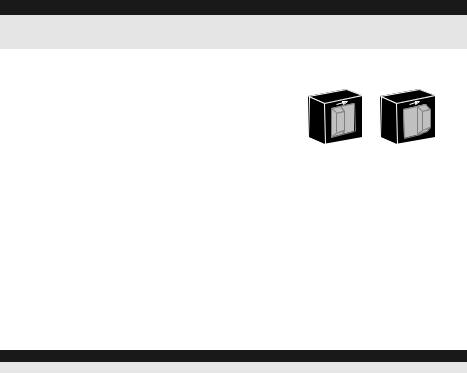
LEDs Display
LED |
State |
Description |
GREEN |
Steady |
Indicates upper PIR detection |
YELLOW |
Steady |
Indicates moving PIR detection |
RED |
Steady |
Indicates ALARM (Simultaneous 2 PIR channels) |
|
Flashing |
Indicates malfunctioned communication with ProSYS (BUS mode |
|
|
only) |
All LEDs |
Flashing |
Unit initialization on power up |
|
(One after |
|
|
another) |
|
Notes:
1.DIP-Switch 1 should be in ON position to enable LED indications.
2.Only one LED is active at any one time. For example, in the case of both PIR channels detection, either the steady yellow LED or the steady green LED is displayed (the first to detect), followed by the alarm red LED.
Relay Mode / Bus Mode Jumper
J-BUS jumper (located on the PCB between the red and green LEDs) is used to de operation as follows:
Optional Swivel Installation (Not Supplied)
Relay
Mode
NO
BUS Mode
NO
Please follow the instructions below for mounting the detector with the Standard Swivel:
1.Open WatchOUT front cover (Unlock C1, Figure 1).
2.Release internal base (Unlock I1, Figure 2).
3.Open knockouts on external base (Figure 8, Detail B)
W1: Wires knockout
S1,S2: Knockouts for securing external base to Standard Swivel
S3: External base locking screw knockout
4.On the swivel accessory remove the required swivel cable wiring knockout S2, S7 or S9 (Figure 8, Detail A).
5. Remove back tamper from the internal base (see “ChangingBack Tamper Position" paragraph) and connect it to S5 (Figure 8, Detail A) on the Standard Swivel.
6. Select the mounting installation as follows:
Note:
Ensure that you see the engraved UP mark on the upper front face of the swivel.
Wall Mounting
a.Insert external cable wiring through knockouts S2, S7 or S9 and extract them (including the tamper wires) through the Swivel Wires Passage (Figure 8, Detail B).
b.Secure swivel to the wall through holes S1, S3, S6 and S8.
10 |
WatchOUT PIR Installation Manual |
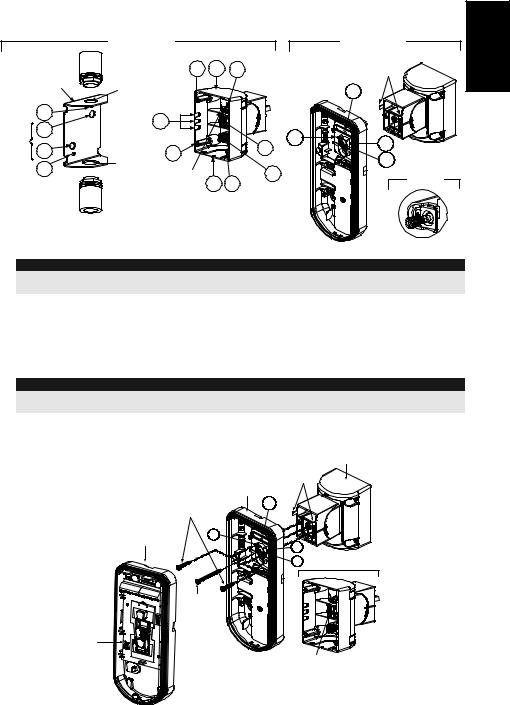
Swivel Conduit Mounting (using Conduit Metal Swivel Adaptor - CSMA, Figure 8, Detail A)
|
|
Detail A |
|
|
|
Detail B |
|
|
Standard Swivel |
|
|||
|
|
S1 |
S2 |
S3 |
|
Snaps |
|
|
|
|
|
|
|
|
CSMA |
Ø 16 mm |
|
|
|
W1 |
|
|
|
|
|
|
|
|
M1 |
|
|
|
|
|
|
|
S9 |
|
|
|
|
Tamper |
M2 |
|
|
|
|
|
|
|
|
|
S1 |
|
|
Spring |
|
|
|
|
S2 |
|
|
|
|
|
S4 |
||
Holes M3 |
S8 |
|
|
|
||
|
|
|
S3 |
|||
|
|
Ø 21 mm |
|
|
|
|
|
M4 |
|
|
|
|
|
|
Swivel Wires |
|
|
S5 |
|
|
|
|
|
|
Detail C |
||
|
|
S7 |
S6 |
|
||
|
|
Passage |
Tamper |
|||
|
|
|
||||
|
|
|
|
|
(see Detail C) |
|
English
Figure 8
Note:
The CSMA is required when wiring is in a pipe external to the wall. It should be ordered separately P/N RA300S.
a.Choose the direction upon which to mount the CSMA according to the required diameter: 16mm (0.63 inches) or 21mm (0.83 inches).
b.Insert conduit to the CSMA.
c.Secure CSMA to the wall through points (M1, M4).
d.Insert external cables and tamper wires from the conduit through the swivel wires passage of the swivel (Figure 8, Detail A).
e.Secure swivel to the wall through holes S1, S3, S6 and S8.
Note:
The Tamper spring S5 (Figure 8) should make contact with the wall through the tamper spring holes M2 or M3 on the CSMA. Make sure to hear the tamper "Click" when connecting to the wall.
7.Insert tamper wires and external cable wiring from Standard Swivel through knockout W1 on the external base (Figure 8, Detail B).
8.Connect the external base to the swivel using the dedicated snaps (Figure 9).
See Detail A
Snaps 
External Base
Swivel to External Base |
W1 |
|
|
Connecting Screws |
|
S1
Internal Base
S2
S3
Detail A
Angle Locking
Screw
(See Note 2)
PCB
Swivel Assy
Connecting Screw
(See Note)
Figure 9
WatchOUT PIR Installation Manual |
11 |
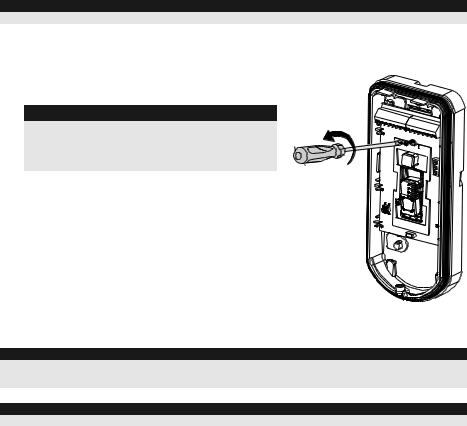
NOTE:
Do not open or close the Swivel Assy Screw since it is used for connecting the swivel parts only.
9.Secure external base to swivel with two screws fastened to knockouts S1 and S2 (Figure 9).
10.Insert the supplied angle locking screw from the external base through the angle locking screw knockout S3 on the external base to the standard swivel (Figure 9).
11. Rotate the Swivel to the desired position. Once the Standard Swivel is in the desired position, secure the angle locking screw.
IMPORTANT!
Take care not to tilt the detector upwards and downwards. The detector should remain perpendicular to the ground for maximum detection and reliability.
12. Line up the internal base onto the external base. Insert all wiring cables through the internal base.
13. Secure internal base to external base (Lock I1, Figure 2).
14. To readjust the Standard Swivel when the PCB is installed (Figure 10):
a. Bend down the black foam located below the RED LED on the PCB (enough to reach the Swivel locking screw).
b. Use a Philips screwdriver to release the |
|
locking screw (see Figure 10). |
Figure 10 |
|
c.Rotate the Swivel to the desired position.
d.Secure the angle locking screw.
NOTE:
When marks on the two movable parts are aligned (Figure 9), the Swivel is in 0 vertical /horizontal position. Each click from this position represents shifting of 5 in vertical / horizontal position.
15. Close the front cover (Lock C1, Figure 1) and walk test the detector.
NOTE:
The screw has to pass through External Base and locked to the swivel.
Replacing Lenses
1.Unlock the six screws that hold the lens holding sleeve from the back of the front cover.
2.To release the protective sleeve, gently push the lens from the external side of the front cover.
3.Disconnect the lens from the sleeve by gently pushing the lens clips that secure it to the sleeve.
4.Replace the lens. Place the 4 clips of the lens into the matching holes on the sleeve.
5.Insert the protective sleeve back into place on the front cover. Pay attention to place the sleeve over the sealing rubber.
6.Secure the 6 holding screws back to their place.
12 |
WatchOUT PIR Installation Manual |

Lens Locking
Clips
Sleeve Locking
Screws
Sealing Rubber
Lens Protecting
Sleeve
Holes for
Lens Clips
Front Cover
Locking Screw
Technical Specification
 Electrical
Electrical
Current consumption (Relay |
31mA at 12 VDC (Stand by) |
|
Mode) |
44mA at 12 |
VDC (MAX with LED ON) |
Current consumption (BUS |
34mA at 12 |
VDC (Stand by), |
Mode) |
47mA at 12 |
VDC (Max. with LED ON) |
Voltage requirements |
9 -16 VDC |
|
Alarm contacts |
24 VDC, 0.1A |
|
Auxiliary Relay |
30 VDC, 1A |
|
Physical |
|
|
Size (including hood) |
220 x 115 x 123mm (8.7 x 4.5 x 4.85 in.) |
|
LxWxD |
|
|
Environmental |
|
|
Operating/Storage temperature |
-30°C to 60°C (-22°F to 140°F) |
|
* PIR technology is limited in rough environmental conditions.
Ordering Information
Model |
Description |
WatchOUT 312PR |
WatchOUT PIR |
Accessories Kits
Model |
Description |
Weight |
RA300S |
Standard Swivel Kit |
0.21 Kg (0.46 lb) |
RA300P |
WatchOut Pole Adaptor Kit |
0.25 Kg (0.55 lb) |
WatchOUT PIR Installation Manual |
13 |
English

BUS Mode Installation
Introduction
The information in this section relates to WatchOUT 312PR installation in BUS Mode only. Up to 32 bus detectors can be installed on the ProSYS RS485 bus, saving cabling time and enabling remote control and diagnostics.
Terminal Wiring
+,-
YELLOW
GREEN
Used for the connection of 12VDC power supply. Connect the (+) terminal to the AUX RED and the (–) terminal to the COM BLK of the ProSYS terminals Used for data communication with the ProSYS. Connect to the terminal to the BUS YEL of the ProSYS
Used for data communication with the ProSYS. Connect to the terminal to the BUS GRN of the ProSYS
TAMPER |
Used for the wiring for tamper detection, see below |
|
|
|
|
||||||||
LED |
|
Used for the wiring for tamper detection, see below |
|
|
|
|
|||||||
ENABLE |
|
|
|
|
|
|
|
|
|
|
|
||
|
|
Cover and Back Tamper |
|
|
Cover Tamper Only |
|
|||||||
|
ProSYS |
BUS Mode: |
|
|
|
|
|
|
|
|
|||
|
Cover + Back tamper wiring |
ProSYS |
|
|
|
|
|
||||||
|
|
|
|
BUS Mode: |
|
||||||||
|
|
|
|
|
|
|
|
|
|||||
|
|
|
BACK |
|
|
|
|
|
|
Cover Tamper Wiring |
|||
AUX |
COM |
|
TAMPER (N.C) |
|
|
|
|
|
|
|
|
|
|
BUS |
|
|
|
|
|
|
|
|
|
|
|
||
RED |
BLK |
YEL GRN |
|
|
|
AUX |
COM |
BUS |
Short |
|
|
|
|
|
|
|
Short |
|
|
RED |
BLK |
YEL |
GRN |
|
|
|
|
|
|
|
|
|
|
|
|
|
|||||
|
|
|
|
|
|
|
|
|
|
|
|
|
|
+ |
- |
YEL GRN |
ALARM TAMPER FREE |
LED |
FREE |
N.O COM N.C |
|
|
|
|
|
|
|
ENABL |
|
|
GRN ALARM TAMPER FREE |
LED |
FREE |
|
|||||||
|
|
|
|
|
+ |
- |
YEL |
N.O COM N.C |
|||||
|
|
|
|
|
|
ENABL |
|||||||
|
|
|
|
|
|
|
|
|
|
|
|
|
|
|
|
|
|
|
|
Cover Tamper to Zone Input |
|
|
|
|
|||
ProSYS |
|
Zone |
BUS |
|
Input |
|
|
|
AUX |
COM |
BUS |
Z1 |
COM |
Z2 |
|
RED |
BLK |
YEL |
GRN |
|
|
|
Short
BUS Mode:
Cover Tamper to Zone Input
|
|
|
|
|
|
|
|
|
|
|
|
|
|
|
+ |
- |
|
YEL |
GRN ALARM |
TAMPER |
FREE |
LED |
FREE |
N.O |
COM |
N.C |
|||
|
ENABL |
|||||||||||||
|
|
|
|
|
|
|
|
|
|
|
|
|
|
|
DIP Switch Settings
DIP Switch |
Description |
Number |
|
|
Used to set the detector ID number. (See Table 1) Set the ID number in the |
1 - 5 |
same way as for any other ProSYS accessory (Refer to the ProSYS installation |
|
instruction manual) |
6 - 8 |
Not used |
14 |
WatchOUT PIR Installation Manual |

WatchOUT ID: DIP Switches 1 - 5 |
|
|
|
|
|
|
|
|
|
|
|
|
|
English |
||||||||||
|
|
|
|
|
|
|
|
|
|
|
|
|
|
|
|
|
|
|
|
|
|
|
|
|
ID |
1 |
|
2 |
|
3 |
|
4 |
|
5 |
|
ID |
1 |
|
2 |
|
3 |
|
4 |
|
5 |
|
|
||
|
|
|
|
|
|
|
|
|
|
|
|
|||||||||||||
01 |
OFF |
OFF |
OFF |
OFF |
OFF |
|
17 |
OFF |
OFF |
OFF |
OFF |
ON |
|
|
|
|||||||||
02 |
ON |
OFF |
OFF |
OFF |
OFF |
|
18 |
ON |
OFF |
OFF |
OFF |
ON |
|
|
|
|||||||||
03 |
OFF |
ON |
|
OFF |
OFF |
OFF |
|
19 |
OFF |
ON |
|
OFF |
OFF |
ON |
|
|
|
|||||||
04 |
ON |
|
ON |
|
OFF |
OFF |
OFF |
|
20 |
ON |
|
ON |
|
OFF |
OFF |
ON |
|
|
|
|||||
|
||||||||||||||||||||||||
05 |
OFF |
OFF |
|
ON |
|
OFF |
OFF |
|
21 |
OFF |
OFF |
ON |
|
OFF |
ON |
|
|
|
||||||
06 |
ON |
|
OFF |
|
ON |
|
OFF |
OFF |
|
22 |
ON |
|
OFF |
ON |
|
OFF |
ON |
|
|
|
||||
07 |
OFF |
ON |
|
|
ON |
|
OFF |
OFF |
|
23 |
OFF |
ON |
|
ON |
|
OFF |
ON |
|
|
|
||||
08 |
ON |
|
ON |
|
|
ON |
|
OFF |
OFF |
|
24 |
ON |
|
ON |
|
ON |
|
OFF |
ON |
|
|
|
||
09 |
OFF |
OFF |
OFF |
ON |
|
OFF |
|
25 |
OFF |
OFF |
OFF |
ON |
|
ON |
|
|
|
|||||||
10 |
ON |
|
OFF |
OFF |
ON |
|
OFF |
|
26 |
ON |
|
OFF |
OFF |
ON |
|
ON |
|
|
|
|||||
11 |
OFF |
ON |
|
OFF |
ON |
|
OFF |
|
27 |
OFF |
ON |
|
OFF |
ON |
|
ON |
|
|
|
|||||
12 |
ON |
|
ON |
|
OFF |
ON |
|
OFF |
|
28 |
ON |
|
ON |
|
OFF |
ON |
|
ON |
|
|
|
|||
13 |
OFF |
OFF |
|
ON |
|
ON |
|
OFF |
|
29 |
OFF |
OFF |
ON |
|
ON |
|
ON |
|
|
|
||||
14 |
ON |
|
OFF |
|
ON |
|
ON |
|
OFF |
|
30 |
ON |
|
OFF |
ON |
|
ON |
|
ON |
|
|
|
||
15 |
OFF |
ON |
|
|
ON |
|
ON |
|
OFF |
|
31 |
OFF |
ON |
|
ON |
|
ON |
|
ON |
|
|
|
||
16 |
ON |
|
ON |
|
|
ON |
|
ON |
|
OFF |
|
32 |
ON |
|
ON |
|
ON |
|
ON |
|
ON |
|
|
|
ProSYS Programming
The following section describes the additional software programming options, added to the ProSYS software, that concern the settings of the Without PIR as a BUS detector. Up to 32 BUS detectors can be added to the system (16 in ProSYS 16) and each of them comes at the expense of a zone in the system.
It is recommend reading and fully understanding the ProSYS Installation and User Manuals, before programming the WatchOUT.
Notes:
The WatchOUT is compatible with the ProSYS software Version 4.xx and above.
The WatchOUT can be programmed via the U/D Software from UD Version 1.8 and above.
For maximum operation stability, it is best NOT to exceed a total of 300 meters (1000 feet) of wiring when connecting the WatchOUT to the BUS
The WatchOUT is part of a new accessory category, BUS zones. Therefore, Adding/Deleting the WatchOUT is identical to any other accessory with the following exception:
Each BUS Zone Detector should be assigned to a Regular Zone.
Any BUS detector can be assigned to a physical wired zone or to a virtual zone.
Physical zone: Any zone on the ProSYS PCB (zones 1-8) or on a wired zone expander (ZE08, ZE16).
Virtual zone: Any zone on a BUS zone expander defined as BZ08 or BZ16.
Notes:
Virtual BUS zones are cost effective. They enable to expand your system zones without adding physical zone expanders.
The virtual BUS zone expander can be used only for BUS zone detectors.
To add a BUS zone expander select type BZ08 or BZ16 when adding a zone expander (Quick key [7][1][2])
To Add / Delete the WatchOUT 312PIR
1.From the installer menu enter the Add/Delete menu: Quick Key [7][1][9][5] for BUS Zones detectors
2. Use the  /
/  or
or  /
/  keys to position the cursor over the Bus Zone ID number for which you want to assign (or delete) a detector.
keys to position the cursor over the Bus Zone ID number for which you want to assign (or delete) a detector.
Note:
Make sure that the detector's physical ID number is identical to the ID number you select during programming
3. Place the cursor on the TYPE field and use the  /
/  key to select OPR12 for the WatchOUT 312PIR detector.
key to select OPR12 for the WatchOUT 312PIR detector.
WatchOUT PIR Installation Manual |
15 |

4.Press  /
/  to confirm.
to confirm.
5.Repeat the process for the other BUS detectors.
Assigning the WatchOUT 312PIR to a Zone
1.From the main installer menu enter Zones: One by One option (Quick key [2][1])
2.Select the zone number that you want to assign the BUS detector.
Note:
If you defined a BUS Zone Expander select a zone number from the virtual zones (defined by the BUS zone expander).
3.Define Partitions, Groups, Zone Type and Zone Sound.
4.In the Termination category select [5] Bus Zone followed by  /
/  . The
. The
following display appears:
Z:001 LINK TO: ID:01 TYPE:OPR12
5.Select the BUS zone number to assign to the programmed zone. The type field will be updated automatically when selecting the BUS zone.
6.Press  /
/  . The loop response category is not applicable to a BUS zone and the following display appears:
. The loop response category is not applicable to a BUS zone and the following display appears:
Z:001 RESPONSE:
N/A-BUS ZONE
7. Press  /
/  , assign label and press
, assign label and press /
/ 
Configuring the WatchOUT 312PIR Parameters
1.To access the WatchOUT settings option press [2][0][3] from the main installer menu. The following display appears:
B-ZONE PRMS:
ZONE#=001 (M:ZZ)
2.Select the zone that the BUS zone was assigned to and press  /
/  . You can now program the WatchOUT parameters as follows:
. You can now program the WatchOUT parameters as follows:
Zones Miscellaneous: BUS Zone
Quick Keys Parameter |
Default |
||
|
|
|
|
[2][0][3][zzz] |
LEDS |
3 LEDS |
|
[1] |
|||
|
|
||
|
|
||
|
Defines the LEDS operation mode |
|
|
[2][0][3][zzz] |
Off |
|
|
[1][1] |
|
||
|
|
||
|
Disables the LEDS operation |
|
|
[2][0][3][zzz] |
Red Only |
|
|
[1][2] |
|
||
|
|
||
|
Only the Red led will operate. This option is highly recommended to avoid |
||
|
the possibility that the behaviorintruder. |
||
[2][0][3][zzz] |
3 LEDS |
|
|
[1][3] |
|
||
|
|
||
|
All 3 LEDs will operate |
|
|
[2][0][3][zzz] |
PIR Sensitivity |
Normal |
|
[2]
Defines the PIR sensitivity of the detector
[2][0][3][zz] |
Sensitivity Options |
|
[2][1]..[4] |
||
|
16 |
WatchOUT PIR Installation Manual |

Zones Miscellaneous: BUS Zone
Quick Keys Parameter |
|
|
Default |
||
|
|
|
|
|
|
|
1) Low |
3) Normal |
|
|
|
|
2) Medium |
4) High |
|
|
|
[2][0][3][zzz] |
Lens Type |
|
|
Wide Angle |
|
[3] |
|
|
|||
|
|
|
|
||
|
|
|
|
||
|
Defines the actual Lens of the detector |
||||
[2][0][3][zzz] |
Lens Type Options |
|
|
||
[3][1]..[2] |
|
|
|||
|
|
|
|
||
|
|
|
|
||
|
1) Wide Angle |
2) Barrier / Long Range |
|||
[2][0][3][zzz] |
Auxiliary Relay Mode |
|
No |
||
[4] |
|
||||
|
|
|
|
||
|
|
|
|
||
|
Defines the operation of the Auxiliary relay of the detector |
||||
[2][0][3][zzz] |
Off |
|
|
|
|
[4][1] |
|
|
|
||
|
|
|
|
||
|
Auxiliary relay is disabled |
|
|
||
[2][0][3][zzz] |
24 Hours |
|
|
|
|
[4][2] |
|
|
|
||
|
|
|
|
||
|
The Auxiliary Relay will always follow an alarm |
||||
[2][0][3][zzz] |
Night Only |
|
|
|
|
[4][3] |
|
|
|
||
|
|
|
|
||
|
The auxiliary relay output will follow an alarm condition only during night time. |
||||
|
The time defined by the photocell on the PCB. |
||||
[2][0][3][zzz] |
Auxiliary Relay Time |
|
2.2 seconds |
||
[5] |
|
||||
|
|
|
|
||
|
|
|
|
||
|
Defines the time duration that the auxiliary relay is activated |
||||
[2][0][3][zzz] |
Auxiliary Relay Time Options |
||||
[5][1]..4] |
|||||
|
|
|
|
||
|
1) 2.2 seconds |
|
3) 4 minutes |
||
|
2) 2 minutes |
|
4) 8 minutes |
||
Diagnostics
The ProSYS enables you to test parameters that reflect the operation of the detector.
1.From the main user menu press  [4] to access the Maintenance menu.
[4] to access the Maintenance menu.
2.Enter the Installer code (or sub-installer) and press  /
/  .
.
3.Press [9] [1] to for the Bus Zones diagnostic menu.
4.Enter the digit of the zone that you want to test and then press  /
/  . The system will perform the diagnostics test and a list of test parameters will appear, as indicated in the table below.
. The system will perform the diagnostics test and a list of test parameters will appear, as indicated in the table below.
5.Use the keys  /
/ 
 /
/  to view the diagnostics test results
to view the diagnostics test results
User Menu: 4) Maintenance 9) Diagnostic 1) Bus Zone |
|
|
Quick Keys |
Parameter |
|
|
|
|
[4][9][1][zzz] |
Detector Input Voltage: Display the input voltage of the detector. |
|
|
PIR 1 Level: Displays PIR channel 1 DC level. Range 0.1v - 4v |
|
|
PIR 1 Noise Level: Displays PIR channel 1 AC level. Range 0VAC |
|
|
(No noise) - 4VA |
|
|
PIR 2 Level: Displays PIR channel 1 DC level. Range 0.1v - 4v |
|
|
PIR 2 Noise Level: Displays PIR channel 2 AC level. Range 0VAC |
|
|
(No noise) - 4VA |
|
|
WatchOUT PIR Installation Manual |
17 |
English
INDICE DEI CONTENUTI
Installazione in modalità relé |
19 |
Introduzione |
19 |
Installazione |
19 |
Considerazioni per l’installazione |
19 |
Installazione a parete |
21 |
Installazione piana: |
21 |
Installazione angolare di 45° (installazione a sinistra) |
21 |
Modifica della posizione del tamper antirimozione |
22 |
Cablaggio Morsettiera |
22 |
Predisposizione microinterruttori |
23 |
Regolazione area di copertura |
23 |
Prova di movimento |
24 |
Indicatori LED |
25 |
Microinterruttore Modalità Relé / Bus |
25 |
Installazione dello Snodo Standard |
25 |
Installazione a parete |
25 |
Installazione per tubo elettrico |
26 |
Sostituzione delle Lenti |
28 |
Caratteristiche Tecniche |
29 |
Informazioni per l’ordine |
29 |
Kit Accessori |
29 |
Installazione in modalità BUS |
30 |
Introduzione |
30 |
Cablaggio morsettiera |
30 |
Tamper Antiapertura e Antirimozione |
30 |
Solo Tamper Antiapertura |
30 |
Tamper Antiapertura ad un Ingresso di Zona |
30 |
Predisposizione Microinterruttori |
30 |
Programmazione ProSYS |
31 |
18 |
Manuale di installazione WatchOUT PIR |
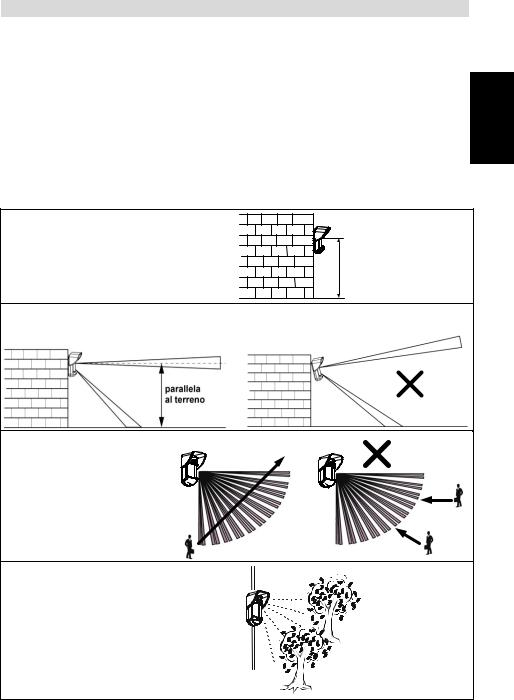
Installazione in modalità relé
Introduzione
Il rivelatore da esterno ad infrarosso passivo WatchOUT di RISCO, è un dispositivo a |
|
|
||
microprocessore che elabora i segnali rilevatiIl |
t |
|||
WLT312 ha un‟area di copertura regolabile. Il rivelatore può funzionare come rivelatore |
|
|
||
tradizionale con uscite a relé collegabili a qualsiasi centrale d’allarme, o |
com |
|||
indirizzato via BUS 485 collegato ai sistemi ProSYS di RISCO. Quando viene collegato ai sistemi |
Italiano |
|
||
ProSYS, il rivelatore può essere programmato e testato sia localmente che in remoto tramite |
|
|||
|
|
|||
tastiere LCD ProSYS e/o software di Teleassistenza. |
|
|
||
Le istruzioni che seguono descrivono l’installaz |
||||
modalità Relé che via BUS. Per informazioni sul collegamento in modalità BUS ProSYS, |
|
|
||
consultare il capitolo il capitoloInstallazione in modalità“ BUS”. |
|
|
||
|
|
|
|
|
Installazione
Considerazioni per l’installazione
1. Altezza possibile: da 0.8m a 1.2m |
|
Altezza tipica: 1m |
0.8m -1.2m |
Angolo di copertura: 90° |
(2'8" - 3'11") |
2.Per ottenere la migliore condizione di funzionamento ed affidabilità, installare il rivelatore perpendicolare al terreno in modo che la zona di rilevazione superiore sia parallela al terreno.
3. Per una migliore rivelazione |
ü |
selezionare una posizione di installazione in modo che l‟eventuale intruso attraversi l‟area di copertura.
4.Evitare di direzionare l‟unità verso oggetti in movimento (alberi ondeggianti, cespugli, ecc.)
Manuale di installazione WatchOUT PIR |
19 |

Installazione del WatchOUT 312PR in situazioni critiche:
Nelle seguenti situazioni variazioni delle radiazioni all‟infrarosso rapide e rilevanti possono far si che entrambi i canali PIR si attivino contemporaneamente, con conseguenti falsi allarmi.
1.Situazioni in cui oggetti riflettenti di vetro e/o metallo di dimensioni superiori ai 70 cm di altezza da terra siano nel campo visivo del rivelatore (automobili, cancelli metallici, saracinesche, muri metallici, finestre, etc.).
2.Situazioni in cui una superficie riflettente a terra con un diametro maggiore di 1m possa causare un riflesso nelle lenti del rivelatore. Per esempio una piscina, una pozzanghera, la strada bagnata, asfalto o cemento molto liscio.
Riflesso dell‟acqua |
NOTE:
a.Si noti che qualsiasi rivelatore PIR da esterno, per evitare falsi allarmi, richiede una riduzione di portata al fine di evitare di proteggere superfici riflettenti come auto, oggetti metallici o pozzanghere.
b.Per ottenere una copertura completa a 15m nelle installazioni sopra descritte, si raccomanda di installare il WatchOUT DT, l’unico rivelatore da esterno con 2 canali PIR e 2 canali a microonde.
c.I rivelatori WatchOUT includono sui sensori PIR dei filtri al silicone di elevata qualità per filtrare le interferenze causate dalle luci bianche. Questi filtri non bloccano le radiazioni termiche ad infrarossi necessarie per rilevazione degli intrusi.
20 |
Manuale di installazione WatchOUT PIR |

Installazione a parete |
|
|
|
|
|
||
Nota: |
|
|
Figura 1 |
Figura 2 |
|
||
|
|
|
|
|
I1 |
|
|
I numeri di riferimento dei fori a sfondare per |
|
|
|
|
|
||
l‟installazione sono marcati sulla base posteriore. |
|
|
|
|
|
||
1. Aprire il coperchio frontale del WatchOUT |
|
|
|
|
|
||
(Svitare C1, Fig. 1). |
|
|
|
|
|
||
2. Sganciare la base interna (svitare I1, Fig. 2). |
|
|
|
|
|
||
3. Selezionare l’altezzallazione come |
|
|
|
|
|
||
segue: |
|
|
|
|
|
|
|
Installazione piana: |
|
|
|
|
|
||
Aprire i fori a sfondare della base esterna (Fig.3) |
|
|
|
|
|
||
|
B1 - B4: Fori a sfondare per |
|
|
|
|
|
|
|
installazione a parete |
|
|
|
|
|
|
|
T1: Foro a sfondare per il tamper |
|
|
|
|
|
|
|
antirimozione |
|
|
|
|
|
|
|
W2 / W3: Fori a sfondare per il |
|
|
|
|
|
|
|
passaggio cavi |
|
|
C1 |
|
|
|
Installazione angolare di 45° |
Figura 3 |
|
|
|
|||
(installazione a sinistra) |
|
T1 |
T6 |
T5 |
|
||
|
|
|
|
|
|
||
a. Aprire i fori a sfondare della base |
|
T3 |
|
|
|
||
|
esterna(Figura 3) |
|
|
|
|
||
|
|
|
|
T4 |
|
||
|
L1, L2: Fori a sfondare per lato |
|
L1 |
|
T2 |
|
|
|
Leva del |
|
|
|
|||
|
|
sinistro |
|
|
|
||
|
|
Tamper |
B1 |
|
R1 |
|
|
|
T3: Foro a sfondare per tamper lato |
|
W5 |
|
|
||
|
B |
|
(non visibile) |
||||
|
|
sinistro |
|
|
|
||
|
|
|
W6 |
|
B2 |
(non |
|
|
|
|
|
|
visibile) |
||
|
W5 / W6: Fori a sfondare per il |
|
|
|
|||
|
|
|
|
|
W7 |
||
|
|
passaggio cavi |
|
|
|
|
|
|
|
|
W3 |
|
W9 W8 |
||
b. Rimuovere la molla del tamper |
|
|
|||||
|
|
|
W2 |
(non |
|||
c. |
Sostituire la staffa 1 del tamper con la |
A |
|
|
visibile) |
||
|
staffa piana 2 del tamper, fornita. |
|
|
|
|
|
|
|
|
|
|
L2 |
|
R2 |
|
|
1 |
2 |
|
|
(non visibile) |
||
|
|
|
|
||||
d. |
Inserire la leva B del tamper in T5 e T3 |
|
|
|
B3 |
|
|
|
|
|
|
|
|
|
|
|
e stringere la vite A (figura 3). |
|
B4 |
|
|
|
|
4. Inserire i cavi esterni attraverso la base |
|
|
|
|
|
||
esterna W2, W3 (installazione piana) o W5, |
Figura 4 |
|
|
|
|||
W6 (installazione a sinistra)(Fig. 3). |
|
|
|
||||
|
|
|
|
|
|||
5. Assicurare la base esterna alla parete. |
|
|
|
|
|
||
6. Inserire i cavi esterni e i cavi del tamper |
|
|
|
|
|
||
attraverso la base interna (Figura 4). |
|
|
|
|
|
||
7. Assicurare la base interna a quella esterna |
|
|
|
|
|
||
(bloccare I1, Figura 2). |
|
|
|
|
|
||
8. Chiudere il coperchio frontale (bloccare C1, |
|
|
|
|
|
||
figura 1) dopo aver |
|
|
|
|
|
||
predisposto i microinterruttori. |
|
|
|
|
|
||
9. Effettuare le prove di copertura. |
|
|
|
|
|
||
Nota: |
|
|
|
|
|
|
|
Per l‟installazione angolare a 45° sul lato destro del rivelatore, usare i riferimenti riportati sulla plastica della base come da tabella seguente, colonna destra:
Descrizione fori a sfondare |
Sinistra |
|
Destra |
Fori a sfondare per il fissaggio della base |
L1, L2 |
|
R1, R2 |
Fori a sfondare molla tamper |
T1,T3 |
|
T2,T4 |
Punto fissaggio vite Tamper |
T5 |
|
T6 |
Fori a sfondare per passaggio cavi |
W5, W6 |
|
W7, W8 |
Manuale di installazione WatchOUT PIR |
21 |
||
Italiano
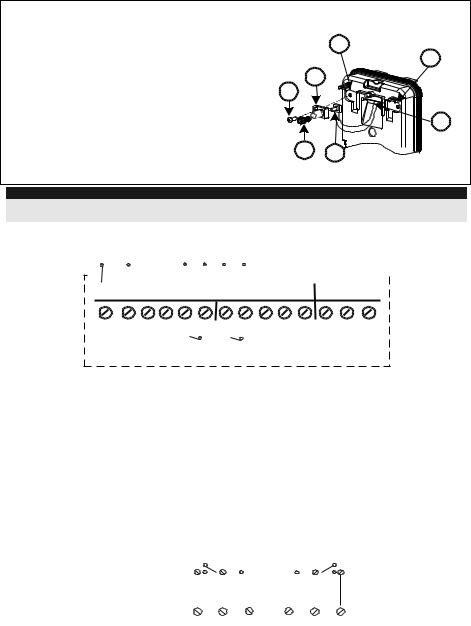
Modifica della posizione del tamper |
Figura 5 |
|
|
|
Predisposizione |
|
|
antirimozione |
|
|
|
|
tamper a sinistra |
Predisposizione |
|
Di fabbrica il tamper antirimozione è fissato sul lato |
|
6 |
|
|
tamper a destra |
||
destro della base interna (vista posteriore). Se si |
|
|
7 |
desidera spostarlo nella parte sinistra (vista |
|
3 |
|
posteriore), procedere come segue (Figura 5): |
|
|
|
|
|
|
|
1. Svitare la vite del tamper 1 per rimuoverlo dalla |
1 |
|
|
posizione 7. |
|
|
|
2. Assicurarsi che la molla 2 del tamper resti |
|
|
5 |
posizionata sulla base 4 del tamper. |
|
|
|
|
|
|
|
3. Assicurarsi che la staffa 3 del tamper resti tra |
2 |
|
|
2 e 4. |
4 |
|
|
|
|
||
4.Fissare la vite 1 del tamper in 3 sulla predisposizione 6.
Note:
1.Verificare che si senta un "Click" quando la molla del tamper viene spinta verso il muro.
2.Per l‟installazione su palo il tamper può essere spostato nella parte inferiore destra della base interna.
Cablaggio Morsettiera
12Vcc
|
|
|
|
|
|
|
|
|
|
|
|
|
|
|
|
|
|
|
|
|
|
|
|
|
|
|
|
|
|
|
|
|
|
|
|
|
|
|
|
|
|
|
|
|
|
|
|
|
|
|
|
|
|
|
|
|
|
|
|
|
|
|
|
|
|
|
|
|
|
|
|
|
|
|
|
|
|
|
|
|
|
|
|
|
|
|
|
|
|
|
|
|
|
|
|
|
|
|
|
|
|
|
|
|
|
|
|
|
|
|
|
|
|
|
|
+ |
|
- |
YEL |
GRN |
|
ALARM |
TAMPER |
FREE |
|
LED |
FREE |
N.O |
COM |
|
N.C |
|
|||||||||||||||||||||||||||||||||||||||||
|
|
ENABL |
|
|
|||||||||||||||||||||||||||||||||||||||||||||||||||||
|
|
|
|
|
|
|
|
|
|
|
|
|
|
|
|
|
|
|
|
|
|
|
|
|
|
|
|
|
|
|
|
|
|
|
|
|
|
|
|
|
|
|
|
|
|
|
|
|
|
|
|
|
|
|
|
|
|
|
|
|
|
|
|
|
|
|
|
|
|
|
|
|
|
|
|
|
|
|
|
|
|
|
|
|
|
|
|
|
|
|
|
|
|
|
|
|
|
|
|
|
|
|
|
|
|
|
|
|
|
|
|
|
|
|
|
+,- YELLOW GREEN ALARM TAMPER FREE
LED ENABLE
N.O
COM
N.C
N.C N.C
SCHEDASCHEDAELTTRONICAELETTRONICAWatchOutWatchOUT312PR - PCBPIR
12 Vcc
Non Usato. (Solo installazione in modalità BUS) Non Usato. (Solo installazione in modalità BUS) Relè N.C., 24Vcc, 0.1A
Relè N.C., 24Vcc, 0.1A
Questo morsetto è un morsetto libero per il posizionamento di cavi o resistenze di fine linea.
Ingresso usato per controllare da remoto i LED quando il microinterruttore 1 è in ON. LED abilitati: Tensione +12V presente o morsetto non connesso.
LED disabilitati: 0V presente all’ingresso.
Uscita a relé programmabile per comandare dispositivi ausiliari come ad esempio telecamere, o luci quando viene rilevato un allarme. Il modo di funzionamento di questa uscita dipende dalla configurazione dei microinterruttori 4 –7.
NORMAL IT A' |
|
|
|
AL L ARME |
||||||||||||
|
|
|
|
|
|
|
|
|
|
|
|
|
|
|
|
|
|
|
|
|
|
|
|
|
|
|
|
|
|
|
|
|
|
|
|
|
|
|
|
|
|
|
|
|
|
|
|
|
|
|
|
|
|
|
|
|
|
|
|
|
|
|
|
|
|
|
|
|
|
|
|
|
|
|
|
|
|
|
|
|
|
|
|
|
|
|
|
N.O |
|
C OM |
|
N.C |
|
N.O |
|
C OM |
|
N.C |
|
|||||
22 |
Manuale di installazione WatchOUT PIR |

Predisposizione microinterruttori
ON
|
|
|
|
|
|
|
|
|
|
|
|
|
|
Default |
|
|
|
|
|
|
|
|
|
|
|
|
|
|
|
|
|
|
|
|
|
|
|
|
|
|
|
|
|
|
1 |
2 |
3 |
4 |
5 |
6 |
7 |
8 |
|
||||||
MIC. 1: Predisposizione LED
ON: LED abilitati
OFF: LED disabilitati
MIC. 2 e 3: Sensibilità rilevazione
Sensibilità |
MIC.2 |
MIC.3 |
Bassa |
Off |
Off |
Media |
Off |
On |
Normale |
On |
Off |
(Default) |
|
|
Massima |
On |
On |
DIP 4: Relè uscita ausiliaria
ON: Abilitato
OFF: Disabilitato
MIC. 5: Utilizzato per configurare la modalità di funzionamento del relè al verificarsi di un allarme, in funzione della fotocellula che gestisce il crepuscolare.
|
|
ON (Notte): Il relé ausiliario si attiva al |
||||||
|
|
verificarsi di un allarme solo durante la |
||||||
|
|
notte. |
|
|
|
|
|
|
|
|
OFF (24 Ore): Il relè ausiliario si attiva |
||||||
|
|
sempre al verificarsi di un allarme |
||||||
MIC. 6-7: Imposta la durata di attivazione del relé |
||||||||
|
|
dell’uscita per i di |
||||||
|
|
Tempo di |
|
|
Microint. 6 |
|
Microint. 7 |
|
|
|
|
|
|
|
|||
|
|
Attivazione |
|
|
|
|
||
|
|
|
|
|
|
|
|
|
|
|
|
|
|
|
|
|
|
|
|
2.2 secondi |
|
|
OFF |
|
OFF |
|
|
|
2.0 Minuti |
|
|
OFF |
|
ON |
|
|
|
4.0 Minuti |
|
|
ON |
|
OFF |
|
|
|
8.0 Minuti |
|
|
ON |
|
ON |
|
MIC. 8: LED Rosso /3 LED
ON: Solo LED rosso
OFF: 3 LED
Italiano
Regolazione area di copertura
Fare scorrere il PIR mobile nella posizione desiderata, vedere figura 6.
L‟impostazione dell‟area di copertura del
PIR inferiore determina la portata di rilevazione del sensore.
Il PIR superiore è fisso e la sua area di copertura è sempre parallela al terreno.
L‟area di copertura inferiore è impostabile da 2m a 12m a seconda di dove si posizioni il PIR regolabile. Quindi, la portata di rilevazione del sensore è stabilita dal posizionamento del PIR inferiore. Per generare una condizione di allarme sia il PIR superiore che quello inferiore devono essere attivati.
Figura 6
Manuale di installazione WatchOUT PIR |
23 |
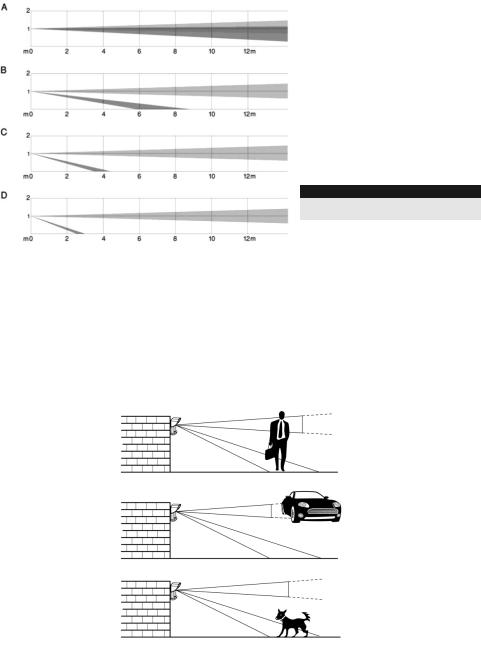
Schema di rilevazione (vista laterale) |
Portata di rilevazione con |
||
|
installazione a 1m: |
||
|
|
|
|
|
|
|
MASSIMA |
|
|
POSIZIONE |
DISTANZA DI |
|
|
|
RILEVAZIONE* |
|
|
A |
12m |
|
|
(40') |
|
|
|
|
|
|
|
|
|
|
|
B |
7m |
|
|
(23') |
|
|
|
|
|
|
|
|
|
|
|
C |
3m |
|
|
(9'10") |
|
|
|
|
|
|
|
|
|
|
|
D |
2m |
|
|
(6'6") |
|
|
|
|
|
|
|
|
|
* NOTA:
La portata può variare in funzione delle condizione climatiche esterne.
Prova di movimento
Dopo 2 minuti dall‟alimentazione del sensore, effettuare una prova di movimento all‟interno dell‟area protetta e verificare il buon funzionamento e la copertura del rivelatore.
Settare il PIR regolabile per ottenere la portata desiderata.
IMPORTANTE!
Entrambi canali devono essere attivati simultaneamente per generare allarme. Vedere figura 7 sotto.
RILEVAZIONE
NESSUNA RILEVAZIONE
NESSUNA RILEVAZIONE
Figura 7
24 |
Manuale di installazione WatchOUT PIR |
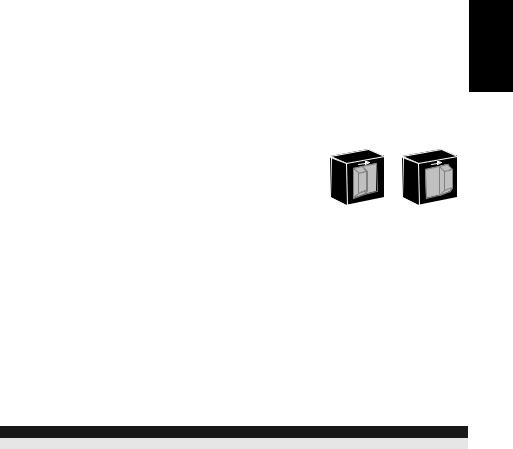
Indicatori LED
|
LED |
Stato |
Descrizione |
|
|
|
|
VERDE |
Acceso |
Indica rilevazione del canale PIR superiore |
|
|
|||
GIALLO |
Acceso |
Indica rilevazione del canale PIR inferiore (quello |
|
|
|
||
|
|
|
regolabile) |
|
|
|
|
ROSSO |
Acceso |
Indica ALLARME (entrambi i PIR hanno rilevato) |
|
|
Italiano |
||
|
|
Lampeggiante |
Indica una anomalia di comunicazione con la |
|
|
||
|
|
|
|
|
|||
|
|
|
ProSYS (solo modalità BUS) |
|
|
|
|
TUTTI I LED |
Lampeggianti () |
Inizializzazione unità a |
|
|
|||
|
|
|
|
|
|
|
|
|
Note: |
|
|
|
|
|
|
|
1. Il microinterruttore 1 va posizionato su ON per abilitare i LED. |
|
|
|
|
||
|
|
|
|||||
|
2. Solo un LED alla volta può illuminarsi. Per esempio, nel caso di attivazione di entrambi i PIR, o il LED giallo o |
|
|
||||
|
quello verde si illumina (il primo che rileva), seguito poi dal LED rosso di allarme. |
|
|
||||
Microinterruttore Modalità Relé / Bus
Il microinterruttore J-BUS, situato sulla scheda tra i LED rosso e verde, viene usato per configurare la modalità di funzionamento del rivelatore.
Modalità
Relè
NO
Modalità
BUS
NO
Installazione dello Snodo Standard
Leggere le istruzioni seguenti per installare il rivelatore con questo snodo.
1.Aprire il coperchio frontale (Allentare C1, Figura 1).
2.Sganciare la base interna (Svitare I1, Figura 2).
3.Aprire i fori a sfondare della base esterna (Figura 8, Dettaglio B)
W1: Passaggio cavi
S1,S2: Fori a sfondare per fissare la base esterna allo snodo standard
S3: Predisposizioni per le viti di fissaggio della base esterna
4.Sullo snodo aprire le predisposizioni per il passaggio cavi S2, S7 o S9 (Figura 8, Dettaglio A).
5.Rimuovere il tamper antirimozione dalla base interna (consultare paragrafo "Modifica della posizione del tamper antirimozione") e collegarlo a S5 (Figura 8, Dettaglio A) sullo snodo standard.
6.Selezionare le opzioni di installazione di seguito descritte:
Nota:
Accertarsi che il marchio UP è presente nella parte frontale superiore dell snodo.
Installazione a parete
a.Inserire il cavo esterno attraverso le predisposizioni S2, S7 o S9 (incluso i cavi del tamper) ed estrarlo facendolo passare attraverso il passaggio cavi dello snodo (Figura 8, Dettaglio B).
b.Fissare lo snodo alla parete tramite i fori S1, S3, S6 ed S8.
Manuale di installazione WatchOUT PIR |
25 |
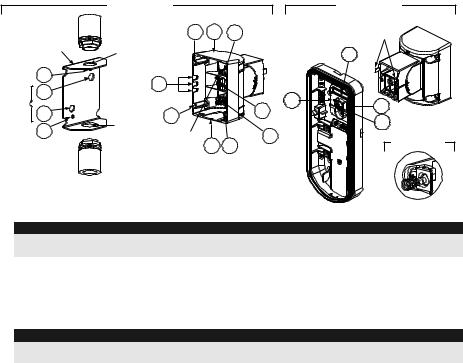
Installazione per tubo elettrico
(utilizzare l’adattatoreCSMA,metallicoFigura 8, Dettaglio A)per tubo elet
|
|
Dettaglio A |
|
|
|
Dettaglio B |
|
|
Snodo Standard |
|
|
||
|
|
S1 S2 |
S3 |
|
Linguette |
|
|
CSMA |
Ø 16 mm |
|
|
|
W1 |
|
|
|
|
|
|
|
|
M1 |
|
|
|
|
|
|
|
S9 |
|
|
|
|
Fori |
M2 |
|
|
|
S1 |
|
molla |
|
|
|
|
S2 |
|
|
|
|
|
S4 |
||
tamper |
M3 |
|
|
|
||
S8 |
|
|
|
|||
|
|
|
S3 |
|||
|
|
Ø 21 mm |
|
|
|
|
|
M4 |
|
|
|
|
|
|
Passaggio |
|
|
S5 |
|
|
|
|
S7 |
S6 |
Dettaglio C |
||
|
|
cavi dello |
Tamper |
|||
|
|
|
||||
|
|
|
|
|
||
|
|
snodo |
|
|
|
|
|
|
|
( vedi Dettaglio C ) |
|
||
|
|
|
|
|
||
Figura 8
Nota:
Il CSMA è richiesto quando il cablaggio viene effettuato tramite una tubazione elettrica esterna alla parete. Questo accessorio va ordinato separatamente con il codice RA300S.
a. Scegliere l’orientamento del CMSA in riferimento. al
b.Inserire il tubo elettrico nel CSMA.
c.Fissare il CSMA alla parete tramite i fori M1 e M4.
d.Inserire i cavi esterni e i cavi del tamper che arrivano dal tubo elettrico facendoli passare tramite il passaggio cavi dello snodo (Figura 8, Dettaglio A).
e.Fissare lo snodo alla parete tramite i fori S1, S3, S6 ed S8.
Nota:
La molla del tamper S5 (Figura 8) deve essere a contatto della parete tramite gli appositi fori M2 o M3 del CSMA. Assicurarsi di sentire il "Click" dell‟interruttore tamper fissando il dispositivo alla parete.
7.Inserire i cavi del tamper e i cavi esterni che arrivano dallo snodo standard facendoli passare tramite la predisposizione W1 della base esterna (Figura 8, Dettaglio B).
8.Unire la base esterna allo snodo utilizzando le apposite linguette ad incastro (Figura 9).
26 |
Manuale di installazione WatchOUT PIR |
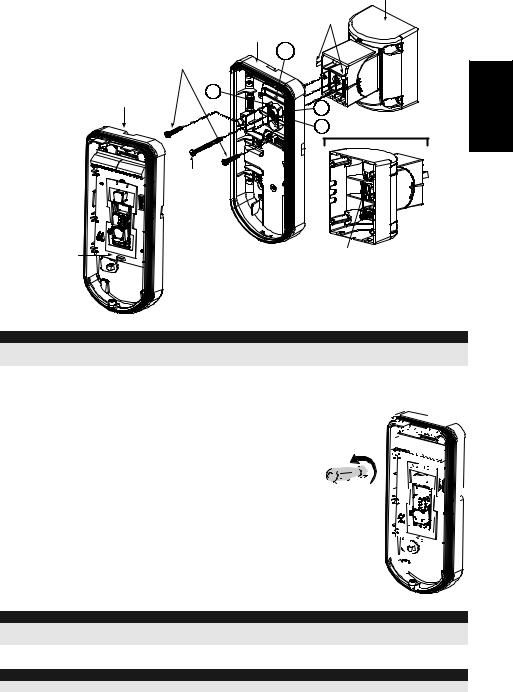
Vedi Dettaglio A
|
|
Linguette |
|
|
|
Base esterna |
|
|
Viti per la connessione dello |
W1 |
|
|
|
|
|
|
snodo con la base esterna |
|
|
|
S1 |
|
|
|
Base interna |
S2 |
|
|
|
|
|
|
|
S3 |
Dettaglio A |
|
|
|
|
|
Vite di blocco |
|
|
|
orientamento |
|
|
|
snodo |
|
|
|
(Vedi nota 2) |
|
|
Scheda |
|
Vite di fissaggio del fermo |
|
elettronica |
|
||
|
posteriore orientamento snodo |
||
|
|
||
|
|
|
(Vedi nota) |
Figura 9
NOTA:
Italiano
Per fissare la base del rivelatore allo snodo non usare la vite che blocca il fermo posteriore dello snodo. Questa vite non va usata poichè serve solo per il blocco dello snodo una volta orientato come desiderato.
9.Fissare la base esterna allo snodo con due viti tramite le predisposizioni S1 e S2 (Figure 9).
10.Inserire nello snodo standard la vite (fornita) di fissaggio ad angolo facendola passare dalla base esterna attraverso il foro a sfondare S3 (Figura 9).
11.Orientare orizzontalmente e verticalmente lo snodo fino ad 
ottenere la posizione desiderata e poi stringere la vite di 

 blocco orientamento snodo
blocco orientamento snodo 












12.Infilare la base interna nella base esterna ed inserire tutti i 








 cavi attraverso la base interna.
cavi attraverso la base interna. 

















13.Fissare la base interna a quella esterna (fissare I1, figura 2). 


















14.Per regolare lo snodo standard quando viene installata la 











 scheda elettronica (Figura 9):
scheda elettronica (Figura 9): 










a.Spostare la gomma nera situata sulla scheda elettronica 







 sotto al LED rosso (quanto basta per raggiungere la vite di
sotto al LED rosso (quanto basta per raggiungere la vite di 










 blocco dello snodo).
blocco dello snodo). 




b.Utilizzare un cacciavite per svitare la vite di blocco (vedi  Figura 10).
Figura 10). 




c.Orientare orizzontalmente e verticalmente lo snodo fino ad 





ottenere la posizione desiderata.
d. Stringere la vite di blocco orientamento snodo. 

 Figura 10
Figura 10
NOTA:
Quando i punti marcati delle due parti mobili sono allineati (figura 9), lo snodo standard si trova in posizione 0°.
Ogni “click” verticale da questa posizione corrisponde ad un incremento / decremento di 5°.
15.Chiudere il coperchio frontale (fissare C1, figura 1) e proseguire con la prova di movimento per verificare l’area di copertura del rivelatore.
NOTA:
La vite deve passare attraverso la base esterna ed essere fissata allo snodo.
Manuale di installazione WatchOUT PIR |
27 |
